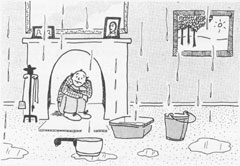Why do Clocks run clockwise? (9 page)
Read Why do Clocks run clockwise? Online
Authors: David Feldman

Submitted by Rick Barber, of Denver, Colorado
.
50 / DAVID FELDMAN

Why Do Many Exterminators Wear Hard Hats?
Our correspondent wondered why one of the largest exterminator companies, in its television commercials, dresses its exterminators with nice pants, a dressy shirt, and a hard hat. Is there any practical reason for the hard hat in real life? Is there a marketing reason?
The practical reason: pest-control operators often have to inspect crawl spaces, basements, and cellars full of obstacles—nails, heat ducts, spider webs, and other protruding objects from above. The hard hat helps reduce accidents.
The marketing reason: the hard hat conveys a professional image.
Subliminally, the hard hat is supposed to make the customer think:
“If the exterminator has to wear a hard hat, this work must be too dangerous for a civilian like me! Better leave it to the experts.”
Submitted by Phil Feldman, of Los Angeles, California
.
WHY DO CLOCKS RUN CLOCKWISE? / 51
Who Was the Emmy That the Emmy Award Is
Named After?
Not who, but what? Unlike the premier theater (Tony) and movie (Oscar) awards, the Emmy isn’t named after a person.
In 1948, the president of the budding National Academy of Television Arts and Sciences, Charles Brown, formed a committee to select the outstanding achievements in television that year. He also asked for suggestions for a name and symbol for the award.
From the start, technological terms were the top contenders.
“Iconoscope” (a large orthicon tube) was an early favorite, but the committee was afraid the name would be shortened to “Ike.” “Tilly”
(for television) was suggested, but cooler heads prevailed. Harry Lubcke, a pioneer television engineer and future president of the academy (1949-1950) offered “Emmy,” a nickname for the image orthicon tube (state-of-the-art circuitry at that time), and it prevailed.
The statue itself was designed by Louis McManus, who received a gold lifetime membership in the academy and one of the six statuettes presented at the first Emmy Awards banquet on January 25, 1949. As McManus went up to receive his award, he is reputed to have been told, “Louis, here she is…our baby. She’ll be here long after we’re gone.” Indeed, long after the image orthicon tube was gone.
52 / DAVID FELDMAN

Why Don’t Dogs Develop Laryngitis, Sore Throats,
Voice Changes, or Great Discomfort After Barking
Continuously?
A caller on a talk show hit us with this Imponderable. The dog next door, left alone by his master, had been barking, continuously, for hours. Why didn’t it hurt the dog’s throat at least as much as the caller’s ears?
We approached several vets and stumped some, but the consensus answer was best expressed by William E. Monroe, D.V.M., Diplo-mate, of the American College of Veterinary Internal Medicine: Dogs do occasionally get laryngitis and voice changes from excessive barking. It is not as common in dogs as in people because the motor control of the canine larynx (voice box) is not as refined as
WHY DO CLOCKS RUN CLOCKWISE? / 53
that of humans for sound production. Therefore, the voice range is narrower and subsequent stress from phonation is probably not as severe. Since barking is not much a part of daily living for most pet dogs as speaking is for people, laryngitis manifested as a voice change is also not as frequently observed in dogs, even though it may be present.
Why Are There Eighteen Holes on a Golf Course?
In Scotland, the home of golf, courses were originally designed with varying numbers of holes, depending on the parcel of land available.
Some golf courses, according to U.S. Golf Association Librarian Janet Seagle, had as few as five holes.
The most prestigious golf club, the Royal and Ancient Golf Club of St. Andrews, originally had twenty-two holes. On October 4, 1764, its original course, which had contained eleven holes out and eleven holes in, was reduced to eighteen holes total in order to lengthen them and make it more challenging. As a desire to codify the game grew, eighteen holes was adopted as the standard after the St. Andrews model.
54 / DAVID FELDMAN
What Does 0° in the Fahrenheit Scale Signify?
During our school days, we were forced to memorize various points in the Fahrenheit scale. We all know that the freezing point is 32°
and that the boiling point is 212°. The normal human body temperature is the inelegantly unround number of 98.6°.
Countries that have adopted the metric system have invariably chosen the Celsius system to measure heat. In the Celsius scale, 0°
equals the freezing point.
The Fahrenheit temperature scale was created by a German physicist named Gabriel Daniel Fahrenheit, who invented both the alcohol thermometer and the mercury thermometer. The divisions of his scale aren’t quite as arbitrary as they might seem. Zero degrees was chosen to represent the temperature of an equal ice-salt mixture, and 100° was originally supposed to signify the normal body temperature. But Fahrenheit screwed up. Eventually, scientists found that the scale didn’t quite work, and the normal body temperature was “down-scaled” to 98.6°.
Submitted by James S. Boczarski, of Amherst, New York
.
What Does Each One-Degree Increment in the
Fahrenheit Scale Signify?
Although his scale was not based on the freezing and boiling points, Fahrenheit recognized their significance. The interval between the boiling point (212°) and freezing point (32°) numbers exactly 180
degrees on the Fahrenheit scale, a figure with which scientists and mathematicians were used to working.
The increments in a temperature scale have no cosmic sig WHY DO CLOCKS RUN CLOCKWISE? / 55
nificance in themselves. The Celsius system, for example, is less precise than the Fahrenheit in distinguishing slight variations in moderate temperatures. Thus while 180 increments on the Fahrenheit scale are necessary to get from the freezing to the boiling point, the freezing point (0°) on the Celsius scale and the boiling point (100°
C) are closer, only 100 increments apart.
In most cases, the meaning of the one-degree increments in temperature scales has more to do with what is intended to be measured by the scale than with any particular mathematical requirements.
The Fahrenheit scale, intended for use in human thermometers, was designed originally to have 100°F represent the normal body temperature. Temperature scales now used by scientists, such as the Kelvin and Rankine scales, use absolute zero (the equivalent of -
273.15° C or -459.67° F) as the base point. Rankine uses the same degree increments as Fahrenheit; Kelvin uses the Celsius degree.
Submitted by James L. Foley, of Calabasas, California
.
56 / DAVID FELDMAN


Why Doesn’t Rain Come Down the Chimney into
the Fireplace When Smoke Can Get out of the
Chimney?
Some residential buildings contain chimney caps, sloping structures that stand atop the chimney, as pictured below: WHY DO CLOCKS RUN CLOCKWISE? / 57
While the rain slides down the slopes, the smoke can easily escape under the cap.
But most buildings don’t contain chimney caps and don’t need them, for even large amounts of water can be absorbed by the bricks and masonry in a chimney. Indeed, the high absorbency of bricks is one of the reasons they are used in chimneys. In buildings of four or more stories, almost any quantity of water will be absorbed without the need of a chimney cap.
Submitted by Michael Jeffreys and Krissie Kraft, of Marina del
Rey, California. Thanks also to: Leonard Scarpace, of Newhall,
California
.
Why Do Curad Bandage Wrappers Sparkle in the
Dark When You Open Them?
Whenever we did promotion for the first volume of
Imponderables
and talked about why wintergreen Life Savers glow in the dark when you bite into them, we invariably received a phone call from someone asking why opening Curad wrappers caused the same phenomenon.
So we wrote to Colgate-Palmolive to unravel this mystery. The adhesive used to seal Curad bandage wrappers contains an ultraviolet dye. Most likely, the excitation and friction caused in the act of opening the wrapper causes the glow, which is visible only in the dark.
The research-and-development department of Colgate-Palmolive adds that static electricity might add to the sparkling effect. The sparkling is perfectly harmless and, if you are cut, a nice diversion from your pain.
58 / DAVID FELDMAN
Why Do Garment Labels Often Say “
Professionally
Dry-Clean Only”?
When was the last time you were propositioned by an
amateur
dry cleaner? Most folks don’t take up dry-cleaning as an avocation, so when we were posed this Imponderable by a caller on the
Owen
Spann Show
, we resolved to ferret out exactly who these dangerous amateur dry cleaners were.
It turns out that the veiled reference in “Professionally Dry-Clean Only” labels is not to incompetent practitioners, but to incompetent machines. What these labels are actually warning you against is cleaning the garments in the coin-op bulk dry-cleaning machines that used to be found frequently in laundromats. As much as anything, the labels are a convenient way for clothing manufacturers to avoid liability for the havoc the machines have wreaked. Molly Chillinsky, of the Coin Laundry Association, says that these bulk dry-cleaning devices are almost extinct; in time, the labels might become so as well.
Karen Graber, communications director of the International Fab-ricare Institute, the Association of [ahem] Professional Dry Cleaners and Launderers, adds that the Federal Trade Commission stipulates that along with the “Professionally Dry-Clean Only” warning, garment manufacturers should inform the consumer of any necessary modification in the basic dry-cleaning process. “Even the most professional dry cleaner might not know without being told that something should be dried at a low temperature, for example, or should not be pressed with steam.” The clothing industry, unfortunately, often forgets to add these warnings.
